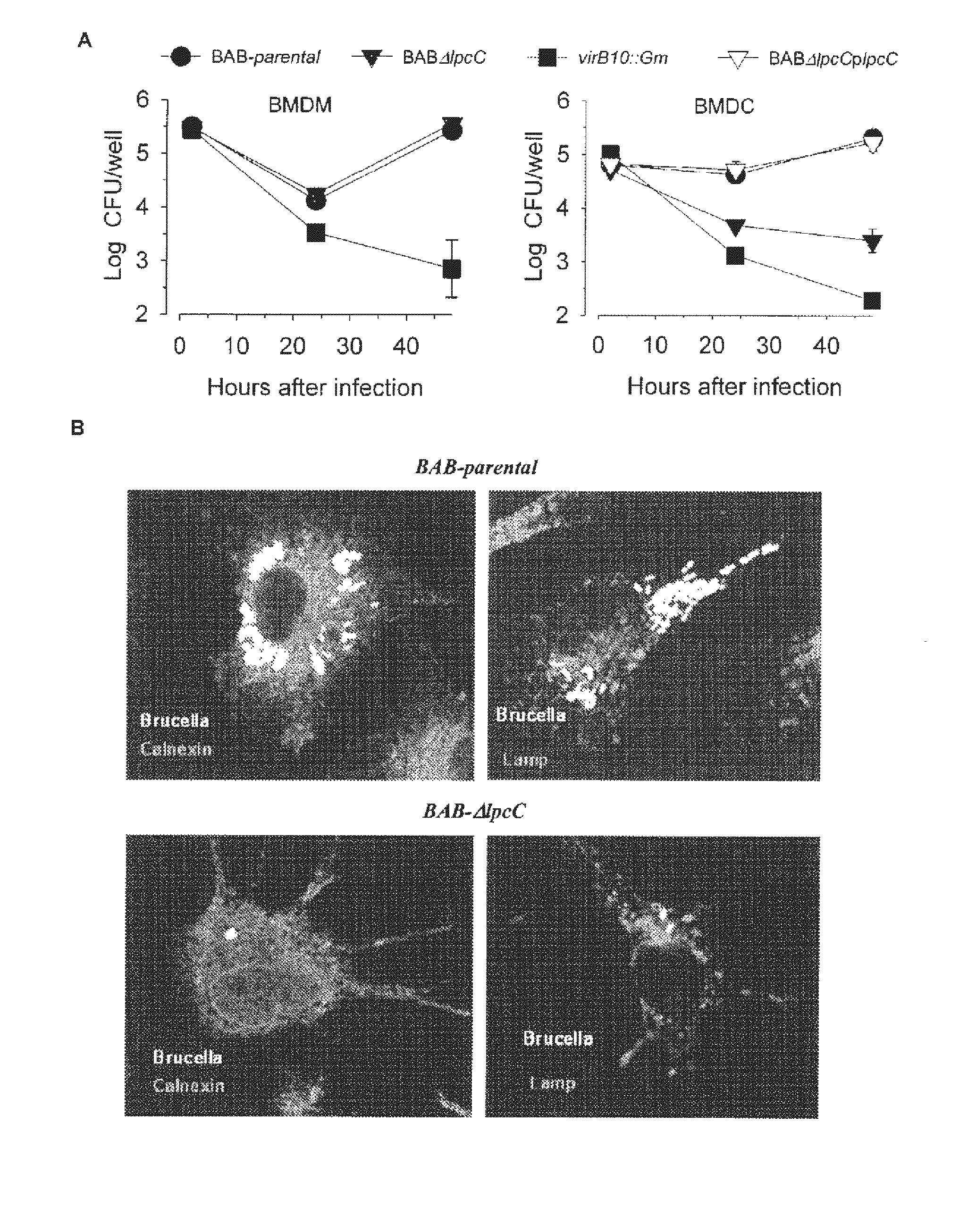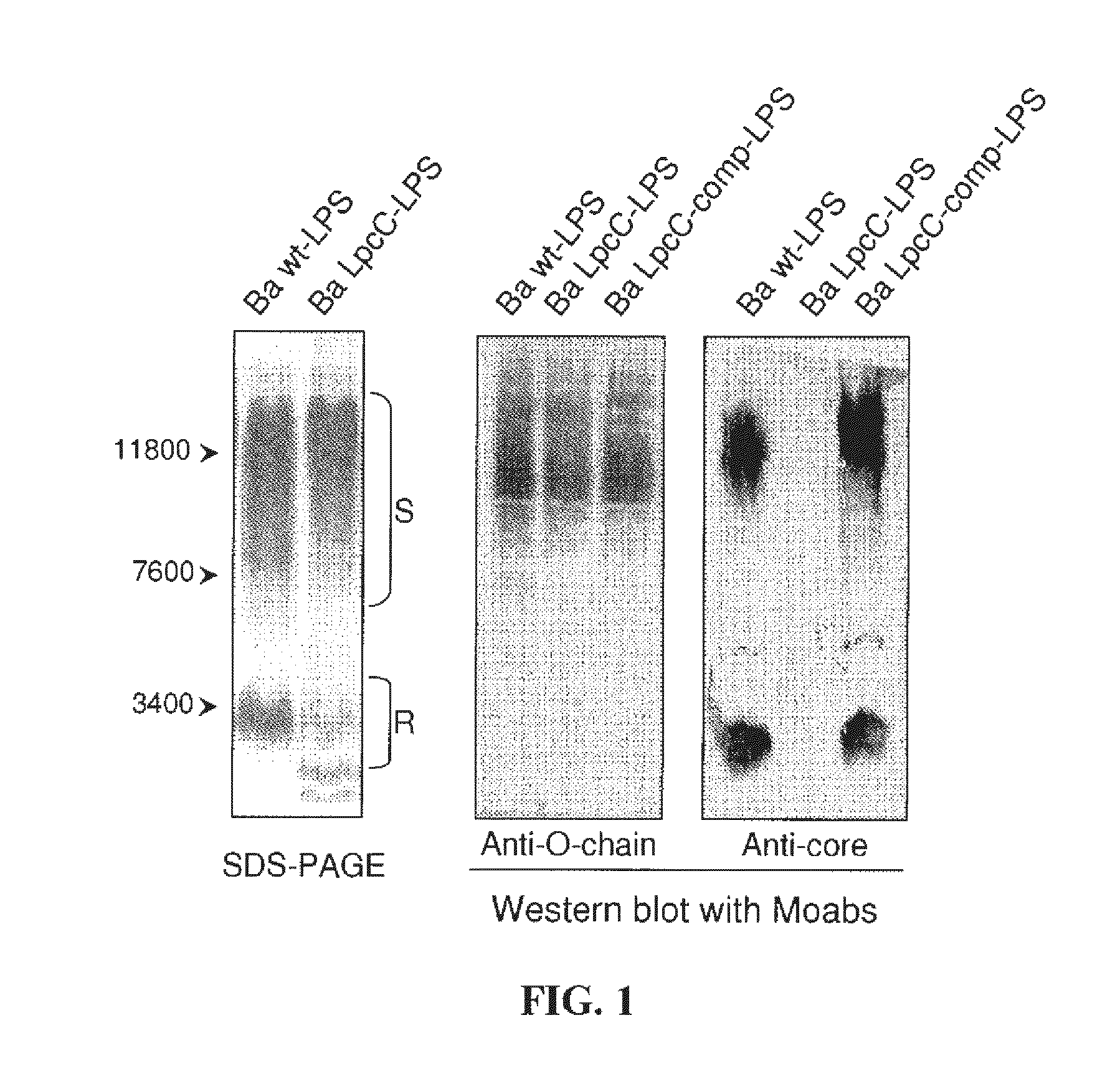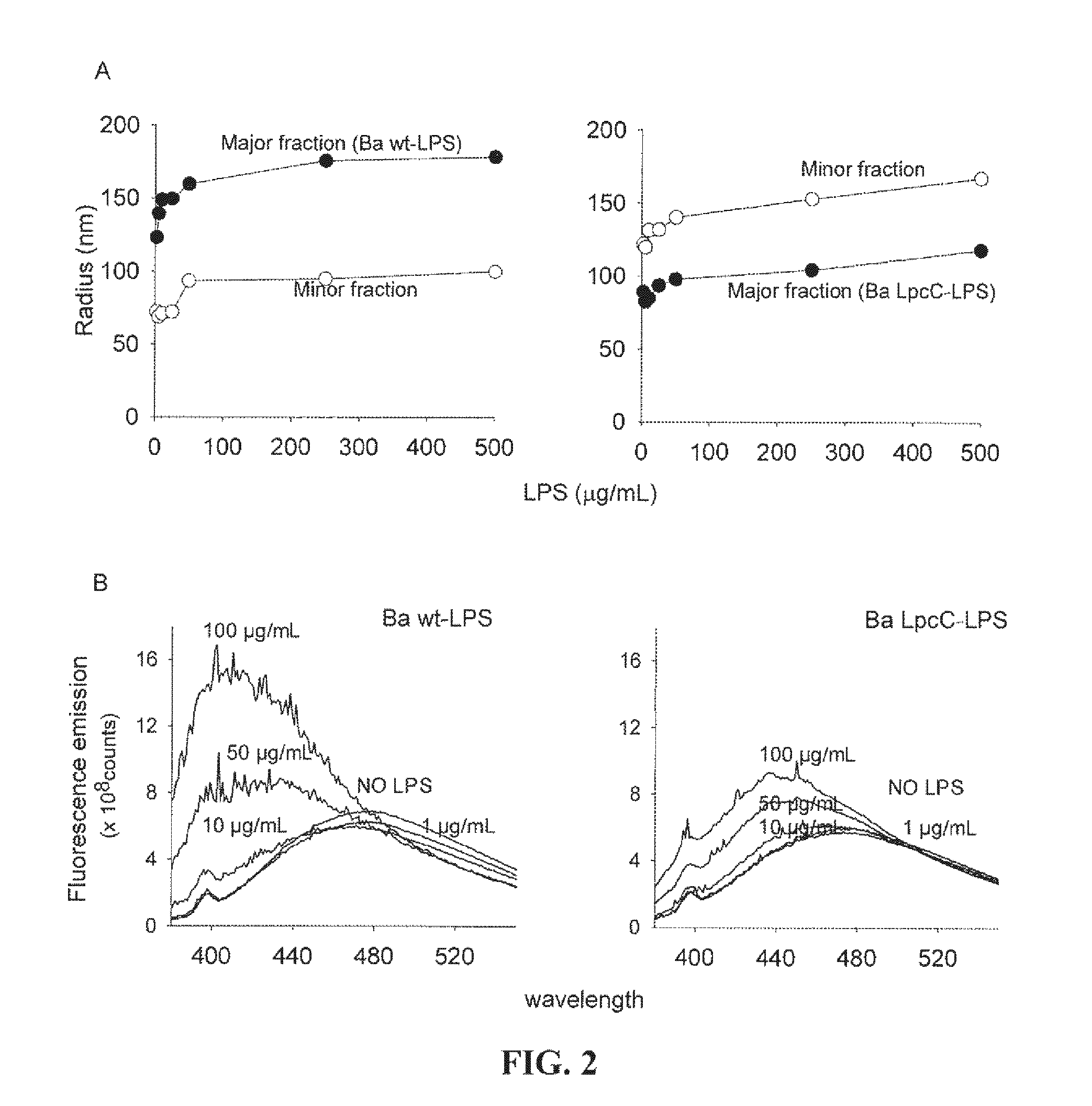Modified gram-negative bacteria for use as vaccines
a technology of gram-negative bacteria and vaccines, which is applied in the direction of antibacterial agents, immunological disorders, antibody medical ingredients, etc., can solve the problems of septic shock, potential fatal endotoxic shock, and its role in virulence has never been studied directly, so as to ensure vaccination, stimulate the immune system, and strengthen the immune response
Active Publication Date: 2012-07-19
UNIV DE NAVARRA +3
View PDF2 Cites 3 Cited by
- Summary
- Abstract
- Description
- Claims
- Application Information
AI Technical Summary
Benefits of technology
[0006]The inventors have found that, by modifying a particular structure of the core of the LPS of Gram-negative bacteria, it is possible to obtain strains having an attenuated virulence but inducing a humoral immunity sufficient for ensuring vaccination of the host. Indeed, the inventors have discovered that particular glycosyltransferases involved in the synthesis of the core of the LPS have a critical role in Gram-negative bacteria virulence. When at least one of these glycosyltransferases is inactivated, the modified LPS synthesized by the Gram-negative bacteria induce a strong immune response of the host and its vaccination. Moreover, the inventors have further shown that the administration to a host of a LPS produced by Gram-negative bacteria wherein at least one of said glycosyltransferases is inactivated induces an unspecific immune response and can thus be used as an adjuvant for stimulating the immune system.DETAILED DESCRIPTION OF THE INVENTION
[0041]A vaccine is defined herein as a biological agent which is capable of providing a protective response in an animal to which the vaccine has been delivered and is incapable of causing severe disease. The vaccine stimulates antibody production or cellular immunity against the pathogen causing the disease; administration of the vaccine thus results in immunity from the disease.
[0045]The vaccine may be administered by intramuscular, intradermal, subcutaneous or intranasal inoculation or injection in an amount which is effective to protect the animal against challenge by a virulent strain of Gram-negative bacterium. This amount may vary according to the animal being inoculated, taking into consideration the size and weight of the animal. The vaccine according to the invention comprises an effective dosage of the Gram-negative bacterium mutant as the active component, i.e. a sufficient amount of Gram-negative bacterium mutant that will induce immunity in the vaccinated animals, against challenge by the virulent Gram-negative bacterium. Immunity is defined herein as the induction of a significant higher level of protection in a population of animals against mortality and clinical symptoms after vaccination compared to an unvaccinated group. In particular, the vaccine according to the invention prevents a large proportion of vaccinated animals against the occurrence of clinical symptoms of the disease and mortality.
[0055]In addition, the invention concerns a vaccine comprising an antigen and an adjuvant wherein said adjuvant comprises a lipopolysaccharide according to the invention. According to this embodiment, the LPS according to the invention enhances the immune response induced by the antigen comprised in the vaccine.
Problems solved by technology
Many species of Gram-negative bacteria are pathogenic, meaning that they can cause disease in a host organism.
When bacterial cells are lysed by the immune system, fragments of membrane containing lipid A are released into the circulation, causing fever, diarrhea, and possible fatal endotoxic shock (also called septic shock).
In particular, its role in virulence has never been studied directly.
However, pure LPS mutants or bacteria expressing LPS mutants are generally considered too toxic to be used as vaccines, in particular in view of their strong adverse effects, and there is thus a need for new vaccines, presenting an attenuated virulence and inducing a sufficient humoral immunity for ensuring vaccination of the host.
Method used
the structure of the environmentally friendly knitted fabric provided by the present invention; figure 2 Flow chart of the yarn wrapping machine for environmentally friendly knitted fabrics and storage devices; image 3 Is the parameter map of the yarn covering machine
View moreImage
Smart Image Click on the blue labels to locate them in the text.
Smart ImageViewing Examples
Examples
Experimental program
Comparison scheme
Effect test
examples
[0069]In the following description, all molecular biology experiments for which no detailed protocol is given are performed according to standard protocols.
the structure of the environmentally friendly knitted fabric provided by the present invention; figure 2 Flow chart of the yarn wrapping machine for environmentally friendly knitted fabrics and storage devices; image 3 Is the parameter map of the yarn covering machine
Login to View More PUM
| Property | Measurement | Unit |
|---|---|---|
| concentration | aaaaa | aaaaa |
| scattering angle | aaaaa | aaaaa |
| concentration | aaaaa | aaaaa |
Login to View More
Abstract
The invention relates to Gram-negative bacteria carrying an inactivated gene encoding a glycosyltransferase involved in the synthesis of the core of the LPS of said Gram-negative bacteria, wherein said inactivated gene results in the synthesis of a LPS having a modified core. These strains have an attenuated virulence but induce a humoral immunity sufficient for ensuring vaccination of the host.
Description
FIELD OF THE INVENTION[0001]The invention generally relates to the field of modified gram-negative bacteria for use as vaccines.BACKGROUND OF THE INVENTION[0002]Gram-negative bacteria are those bacteria that do not retain crystal violet dye in the Gram staining protocol. Many species of Gram-negative bacteria are pathogenic, meaning that they can cause disease in a host organism. This pathogenic capability is usually associated with certain components of Gram-negative cell walls, in particular the lipopolysaccharide (also known as LPS or endotoxin) layer. LPS is a major component of the outer membrane of Gram-negative bacteria, contributing greatly to the structural integrity of the bacteria, and protecting the membrane from certain kinds of chemical attack. LPS also increases the negative charge of the cell membrane and helps stabilize the overall membrane structure. LPS is an endotoxin, and induces a strong response from normal animal immune systems. LPS is additionally an exogeno...
Claims
the structure of the environmentally friendly knitted fabric provided by the present invention; figure 2 Flow chart of the yarn wrapping machine for environmentally friendly knitted fabrics and storage devices; image 3 Is the parameter map of the yarn covering machine
Login to View More Application Information
Patent Timeline
 Login to View More
Login to View More Patent Type & Authority Applications(United States)
IPC IPC(8): A61K39/10A61K39/02A61P31/04A61K31/739A61K39/39A61P37/04C12N1/20C08B37/00A61K39/00
CPCA61K39/098A61K39/39A61K2039/552A61K2039/522A61P31/04A61P37/04
Inventor GORVEL, JEAN-PIERREARCE GORVEL, VILMAIRIARTE, MAITEMORIYON, IGNACIOCONDE-ALVAREZ, RAQUEL
Owner UNIV DE NAVARRA
Features
- R&D
- Intellectual Property
- Life Sciences
- Materials
- Tech Scout
Why Patsnap Eureka
- Unparalleled Data Quality
- Higher Quality Content
- 60% Fewer Hallucinations
Social media
Patsnap Eureka Blog
Learn More Browse by: Latest US Patents, China's latest patents, Technical Efficacy Thesaurus, Application Domain, Technology Topic, Popular Technical Reports.
© 2025 PatSnap. All rights reserved.Legal|Privacy policy|Modern Slavery Act Transparency Statement|Sitemap|About US| Contact US: help@patsnap.com



